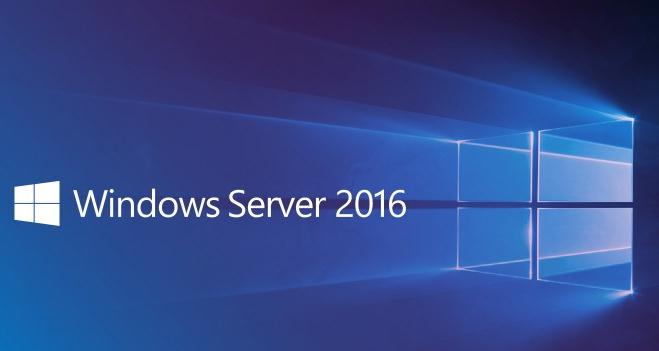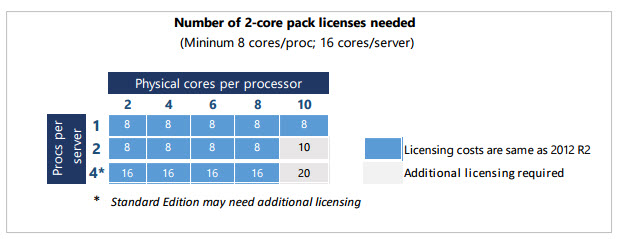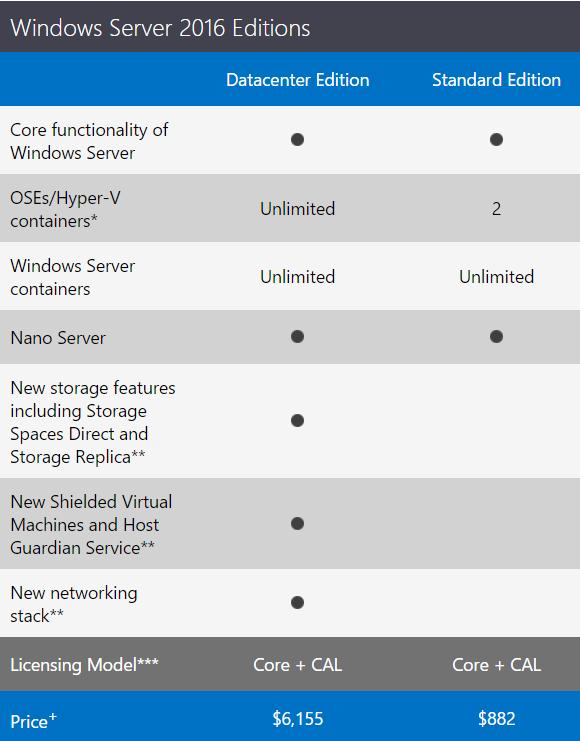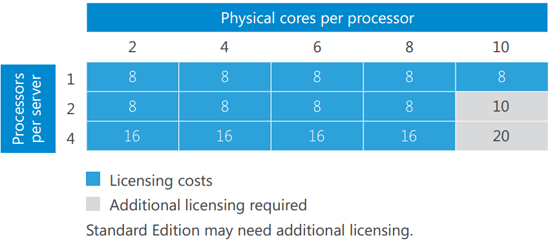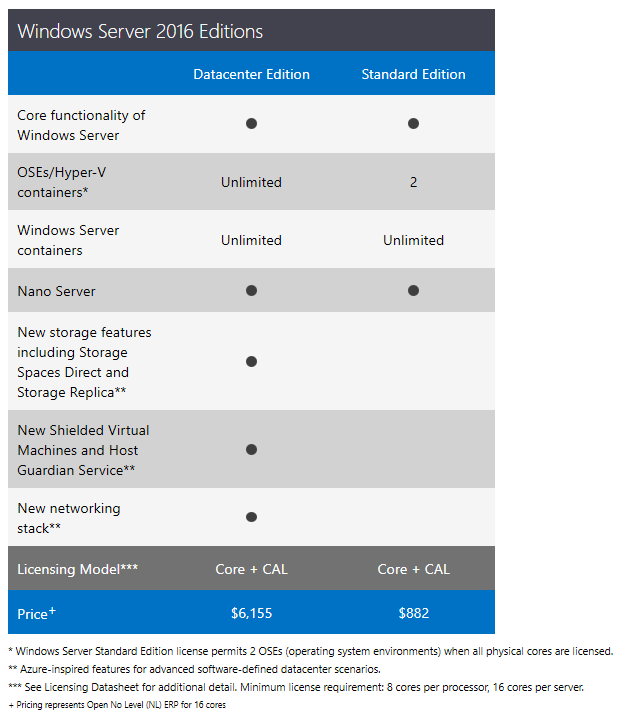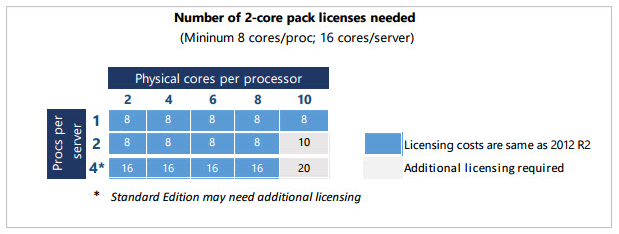В декабре Microsoft выпустила документ, описывающий основные изменения в версиях, политике лицензирования и ценовой политике на редакции своего нового флагмана в нише серверных ОС Windows Server 2016, который готовится к выходу во второй половине грядущего года .
Примечание. Информация об особенностях лицензирования Windows Server 2016 в данной статье основана на документации, которая была опубликована компанией Майкрософт в декабре 2015 года. Скорее всего, до выхода RTM версий Windows Server 2016 политика лицензирования и цены не изменятся. В любом случае, перед покупкой лицензии рекомендуем получить от Microsoft или партнеров актуальную информацию о ценах и правилах лицензирования.
Содержание:
- Лицензирование серверных ядер
- Редакции Windows Server 2016
- Client Access License (CAL) лицензии
- Цены на редакции Windows Server 2016
- FAQ по лицензированию Windows Server 2016
Лицензирование серверных ядер
Главное нововведение в политике лицензирования Windows Server 2016 — переход от лицензирования физических процессоров (подробнее о лицензировании Windows Server 2012 R2) к лицензированию процессорных ядер. Теперь стоимость лицензий будет рассчитываться не по числу процессоров, а по числу ядер системы (аналогично лицензированию Microsoft SQL Server).
Одна лицензия Windows Server 2016 будет стоить в восемь раз дешевле, чем лицензия Windows Server 2012 на два процессора, но одна новая лицензия будет покрывать только два физических ядра.
Этот шаг Microsoft в общем-то ожидаем, т.к. разработчики процессоров за последние несколько лет существенно увеличили количество ядер (и собственно производительность). В частности Intel уже предлагает заказчикам 60 ядерный процессор Intel® Xeon Phi стоимостью 2500$. В Майкрософт представили сколько они потеряют денег при лицензировании по старой модели в случае массового внедрение таких систем и быстренько разработали новую политику лицензирования.
Порядок лицензирования физических ядер сервера таков:
- Должны быть лицензированы все физические ядра сервера (ядра с Hyper-threading считаются одним ядром)
- Минимальное количество приобретаемых лицензий на ядра одного процессора: 8 шт
- Минимальное количество лицензий на ядра одного сервера : 16 шт
- Если процессор отключен на уровне системы, его ядра лицензировать не нужно.
Таким образом, для лицензирования одного физического сервера с двумя четырехядерными процессорами нужно приобрести 8 комплектов двухъядерных лицензий (что будет равно по стоимости одной двухпроцессорной лицензии Windows Server 2012). Для лицензирования однопроцессорного 16-ядерного сервера также понадобится комплект из восьми 2-ядерных лицензий.
Примечание. Таким образом, по сравнению с Windows Server 2012, стоимость лицензий на маломощные сервера не изменится, но для высокопроизводительных систем с несколькими 10-ядерными процессорами, расходы на лицензирование вырастут на 25%.
Редакции Windows Server 2016
На сегодняшний день известно о двух редакциях Windows Server 2016 (как это было с Windows Server 2012/ 2012 R2):
- Windows Server 2016 Datacenter
- Windows Server 2016 Standard
В отличии от Windows Server 2012 R2, в котором разница в редакциях Standard Edition и Datacenter Edition заключалась в количестве поддерживаемых виртуальных машин (2 и неограниченное количество соответственно) и в наличии возможности автоматической активации виртуальных машин в редакции Datacenter. В Windows Server 2016 помимо разницы в возможностях виртуализации, появились и другие функциональные отличия.
В частности Windows Server 2016 Datacenter поддерживает следующие технологии:
- Storage Spaces Direct — расширение технологии Storage Spaces для создания HA хранилищ для кластеров
- Storage Replica – технология блочной синхронной мультисайтовой репликации между кластерами
- Shielded Virtual Machines — технологию создания защищенных виртуальных машин, чей контент защищен от администратора хост-системы Hyper-V
- Host Guardian Service – роль сервера для поддержки защищенных виртуальные машины (Shielded Virtual Machines) и данные на них от несанкционированного доступа
- Network Fabric
- Microsoft Azure Stack — SDN стек на основе Azure
Примечание. Информация о других редакциях Windows Server 2016 и Windows Storage Server 2016 появится в первом квартале 2016 года.
Client Access License (CAL) лицензии
Windows Server Standard и Datacenter по прежнему требуют приобретения лицензий Windows Server CAL для всех устройств или пользователей, использующих сервер.
Клиентские CAL лицензии для Remote Desktop Services и AD Rights Management Services также требуется приобретать отдельно.
Цены на редакции Windows Server 2016
Майкрософт также опубликовала официальные цены на Windows Server 2016. Комплект лицензий на 16 ядер (8 пакетов лицензий по 2 ядра) будет стоить:
- Windows Server 2016 Standard — 882 $
- Windows Server 2016 Datacenter — 6155 $
FAQ по лицензированию Windows Server 2016
В этом разделе буду собирать и отвечать на частые вопросы по лицензированию Windows Server 2016
- Как лицензируется Nano Server?Nano Server это опция установки Windows Server 2016 и не требует дополнительного лицензирования
- Как лицензировать процессоры с Hyper-Threading?В Windows Server и System Center 2016 лицензируются только физические ядра. С этой точки зрения ядро с поддержкой технологии Hyper-Threading являются одним ядром.
- Если процессор/ ядро отключено и не используется Windows, нужно ли покупать на него лицензии?Отключенные процессоры и ядра лицензировать не требуется.
- Как лицензируются виртуальные контейнеры (Hyper-V Containers)Hyper-V Containers контейнеры лицензируются также, как обычные виртуальные машины Hyper-V. На редакции Standard можно запустить 2 виртуальные машины, на Datacenter – неограниченное количество
Время на прочтение
3 мин
Количество просмотров 147K
Недавно Microsoft презентовала более подробную информацию о Windows Server 2016. Уже есть некоторые технические сведения о Hyper-V, Containers, Nano Server и многом другом. Но только сейчас появилась информация о лицензировании Windows Server 2016.
Небольшая оговорка: вся информация в статье взята с документации, выпущенной Microsoft в декабре 2015. В будущем она может меняться. Эта статья служит лишь для обзорного ознакомления с изменениями лицензирования. Если вы хотите убедиться в правильности приобретаемой лицензии, то необходимо связаться с Microsoft или партнером Microsoft.
Microsoft выпустит две версии Windows Server 2016 — Datacenter и Standard, как это было и с Windows Server 2012 и Windows Server 2012 R2. Будет два больших изменения в лицензировании Windows Server 2016:
Первое, Microsoft перейдет от по-процессорного лицензирования на по-ядерное лицензирование в Windows Server 2016 Datacenter и Standard Editions.
И второе большое изменение в том, что не будет функционального равенства между Standard Edition и Datacenter Edition. В Windows Server 2012 R2 в основном были те же самые функции в обоих изданиях и единственная разница была в правах использования виртуальных машин. За исключением автоматической активации виртуальных машин в редакции Datacenter.
Некоторые интересные факты из документации выпущенной Microsoft:
Windows Server 2016 редакции:
- Datacenter Edition предназначается для высоко виртуализированной частной и гибридной облачной среды.
- Standard Edition для невиртуализованной или частично виртуализированной среды.
- Информация о других изданиях Windows Server 2016 и Windows Storage Server 2016 будет представлена в 1 квартале 2016 года.
Примерные цены на редакции Windows Server 2016 выглядят следующим образом:
Что означает изменение модели лицензирования на основе ядер:
Чтобы лицензировать физичесеий сервер, необходимо лицензировать все физические ядра. Минимум 8 лицензий требуется для каждого физического процессора на сервере, и минимум 16 ядер должны быть лицензированы для серверов с одним процессором:
- Цена 16-ядерной лицензий Windows Server 2016 Datacenter и Standard Edition будет такая же как на лицензию 2 процессоров соответствующих изданий Windows Server 2012 R2.
- Standard Edition дает право на установку 2 операционных сред или Hyper-V контейнерев, когда все физические ядра в сервере лицензированы. Несколько лицензий могут быть установлены на некоторые ядра для дополнительных операционных сред или Hyper-V контейнеров.
- Каждому пользователю и / или устройству, требующему доступ к лицензированной Windows Server Standard или Datacenter Edition, требуется Windows Server CAL. Каждый Windows Server CAL позволяет получить доступ к нескольким лицензиям Windows Servers.
- Windows Server CAL дает пользователям или устройствам право на доступ к любой редакции Windows Server той же или более ранней версии.
- Для лицензирования дополнительных или расширенных функций, таких как службы Remote Desktop Services или Active Directory Rights Management Services потребуется, как и ранее, покупка дополнительных лицензий клиентского доступа.
Как лицензировать физические ядра для Windows Server 2016 Standard и Datacenter Editions
- Лицензии для всех физических ядер сервера.
- Минимум 8 лицензий для ядер каждого процессора.
- Минимум 16 лицензий для ядер каждого сервера.
- Лицензии на ядро будут продаваться в паками. По две лицензии в паке.
- Покупка 8 паков будет минимальным требованием для лицензирования каждого физического сервера.
- Стоимость 2х лицензий(паков) для каждого издания составит 1/8-й цены лицензии двух процессоров соответствующих 2012 R2 изданий.
Более детально с лицензированием Windows Server 2016 можно ознакомится на www.microsoft.com/en-us/server-cloud/products/windows-server-2016
C уважением коллектив компании Servilon
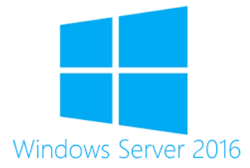
Taking into consideration that the Intel Xeon E7-8890v4 contains a total of 24 cores capable of supporting up to 48 threads, one can quickly understand the software giant’s intention and why it is no longer continuing the per CPU Pair model for its Standard and Datacenter server editions.
Windows Server 2016 License Models
The Windows Server 2016 licensing model consists of per-core/processor + Client Access Licenses (CALs). Each user or device accessing a Windows Server Standard, Datacenter or Multipoint edition requires a Windows CAL or a Windows Server and a Remote Desktop Services (RDS) CAL.
In addition to these changes many would be surprised to know that there is now a minimum number of Per-Core licenses required per physical CPU and Server:
- A minimum of 8 core licenses is required for each physical CPU.
- A minimum of 16 core licenses is required for each server.
- A 2-core license pack is the minimum amount of core licenses you can purchase. E.g you’ll need four 2-core license packs (4×2) to fully license an 8-core CPU.
- The 2-core license is priced at 1/8 (one eighth) the price of a 2-CPU license for corresponding Windows 2012 R2 editions in order to keep the pricing similar. This means the pricing of a 16-core Windows 2016 Datacenter server is equal to a 2-CPU Windows 2012 R2 Datacenter server.
How Licensing Changes Affect Small Windows Server Deployments
Thankfully not much. Microsoft has adjusted its per-Core license pricing in such a way so that a small deployment of up to 16-cores per physical server will be the same pricing as a Windows server 2012 2-CPU License.
Running Windows or Linux Server under ESX or Hyper-V? Get an award-winning backup solution for Free! Download Now!
The price difference becomes apparent for larger customers with a server deployed that exceeds 8-cores per CPU and 16-cores per server. These customers will end up paying additional money for their licenses. For example a server with 2 x Intel Xeon E7-8890v4 CPUs means a total of 48 cores. Installing a Windows server 2012 Standard server means that the initial license will cover up to 16 out of the 48 cores and the customer will need to purchase additional licenses to cover the 32 extra cores! It’s now clear why big customers are going to be paying the big bucks!
The following table explains where additional licenses are required depending on the number of CPUs (processors) and cores per CPU. Remember — Minimum 8 cores/processor; 16 cores/server:
Figure 1. Windows Server 2016 Licensing: Calculating Licensing needs per CPU & Core
Windows Server 2016 Editions Overview, Licensing Models & CAL Requirements
Microsoft offers its Windows Server 2016 in 6 different editions. Let’s take a look at them and explain their primary role and usage:
Windows Server 2016 Datacenter: This edition targets highly virtualized datacenter and cloud environments. Main characteristics include its support for unlimited Hyper-V containers or Operating System Environments (OSEs or virtual machines). It also supports an unlimited number of Windows Server containers and boasts features such Host Guardian Service, Storage Spaces Direct and Storage Replica, Shielded Virtual Machines (VMs), Networking stack and more.
Windows Server 2016 Standard: Used for physical servers or environments with minimal virtualized requirements. This edition supports two Hyper-V containers or Operating System Environments (OSEs or virtual machines) alongside the Host Guardian Service.
The Host Guardian Service is a server role introduced in Windows Server 2016 and found on Windows Datacenter and Standard edition. It serves as a critical security component in protecting the transport key, and works in conjunction with other Windows Server 2016 components to ensure high security levels for Shielded VMs.
Figure 2. Host Guardian Service helps ensure high security levels for Shielded VMs
Windows Server 2016 Essentials: Ideal for small businesses with no more than 25-30 users and 50 devices. This edition is also a great replacement for businesses running Windows Server 2012 Foundation as the same edition is not available for Windows Server 2016.
Windows Server 2016 MultiPoint Premium Server: Allows multiple users to share a single computer while having their own applications and Windows experience and is suitable for academic environments.
Windows Storage Server 2016: Suitable for dedicated storage solutions. It’s available in Standard and Workgroup editions and mainly used by OEM manufactureres.
Microsoft Hyper-V Server 2016: The well-known Free Hypervisor which you can download. This is a stand-alone product that runs directly on the bare-metal server and is built using the same technology as the Hyper-V role on a Windows Server 2016.
Readers can also download here the Free Microsoft Windows Server 2012/2016 Licensing Datasheet that provides additional useful information.
The table below shows the licensing model adopted by each Windows Server 2016 edition:
|
Editions |
Licensing Model |
CAL Requirements |
|
Windows Server 2016 Datacenter |
Core-based |
Windows Server CAL |
|
Windows Server 2016 Standard |
Core-based |
Windows Server CAL |
|
Windows Server 2016 Essentials |
Processor-based |
No CAL Required |
|
Windows Server 2016 MultiPoint Premium |
Processor-based |
Windows Server CAL + Remote Desktop Services CAL |
|
Windows Storage Server 2016 |
Processor-based |
No CAL Required |
|
Hyper-V Server 2016 |
N/A |
N/A |
Table 1. Windows Server 2016 Editions and Licensing Models
Summary
With Windows Server 2016 out it’s only a matter of time before organizations begin to upgrade their servers and use it for new rollouts. Understanding the Windows Server 2016 Licensing model and server editions is critical to ensuring the right choices are made based on the organization’s requirements and server hardware availability. The new Windows Server core-based licensing can be slightly tricky so make sure you know your hardware and license theory well!
Во второй половине 2016 года планируется выход Windows Server 2016 — новой серверной операционной системы от Microsoft. В связи с этим предлагаю вам ознакомиться с информацией ее о редакциях и особенностях лицензирования.
Редакции и их отличие
На данный момент известно о двух основных редакциях Windows Server 2016 — Standard и Datacenter. Редакция Datacenter предназначена для построения высоковиртуализированных облачных или гибридных решений, Standard — для использования в средах, не использующих или мало использующих виртуализацию.
А теперь об изменениях. В Server 2012 редакции не отличались по функционалу, различия были только в количестве поддерживаемых виртуальных машин и возможности их автоматической активации в старшей редакции. В Server 2016 концепция изменилась и редакции Standard и Datacenter имеют не только лицензионные, но и функциональные различия.
К примеру следующие технологии поддерживаются только в редакции Windows Server 2016 Datacenter:
Storage Spaces Direct — расширение технологии Storage Spaces для создания высокодоступных кластерных хранилищ;
Storage Replica — технология блочной репликации данных между хранилищами;
Shielded Virtual Machines — технология защиты содержимого виртуальных машин Hyper-V;
Host Guardian Service — серверная роль, предназначенная для поддержки защищенных виртуальные машины (Shielded Virtual Machines) и защиты их данных от несанкционированного доступа;
Network Fabric — централизованный мониторинг и управление сетевой инфраструктурой;
Microsoft Azure Stack — поддержка software-defined network (SDN) стека для построения гибридных решений.
На картинке ниже приведены различия между редакциями, а также ориентировочные цены на новую ОС.
Лицензирование
Схема лицензирования в Server 2016 тоже подверглась изменениям и теперь лицензирование производится не по сокетам, а по ядрам процессора. Соответственно стоимость лицензии рассчитывается не по числу физических процессоров (как в Server 2012), а по числу процессорных ядер. Подобная схема лицензирования используется в MS SQL Server.
Одна лицензия Windows Server 2016 будет стоить в восемь раз дешевле, чем лицензия Windows Server 2012. Однако одна новая лицензия будет покрывать только 2 физических ядра.
Порядок лицензирования ядер следующий:
• Лицензируются все физические ядра сервера. Ядра с Hyper-threading считаются одним ядром;
• Если процессор отключен на уровне системы, его ядра лицензировать не нужно;
• Минимальное количество приобретаемых лицензий на ядра одного процессора — 8 шт;
• Минимальное количество лицензий на ядра одного сервера — 16 шт.
К примеру, для лицензирования однопроцессорного 16-ядерного сервера потребуется комплект из восьми 2-ядерных лицензий, для одного физического сервера с двумя 4-ядерными процессорами также придется приобрести 8 комплектов 2-ядерных лицензий.
Напомню, что кроме стандартных серверных лицензий Server 2016 требует приобретения лицензий Windows Server CAL для устройств\пользователей, использующих данный сервер. Лицензии для Remote Desktop и RMS также требуется приобретать отдельно.
И отдельно стоит упомянуть лицензирование виртуальных машин и контейнеров (Hyper-V containers). Контейнеры и обычные ВМ лицензируются следующим образом — на редакции Standard можно запускать 2 ВМ или контейнера, на редакции Datacenter их количество не ограничено.
Информация эта опубликована компанией Microsoft в декабре 2015 года. Более подробно с ней можно ознакомиться здесь https://www.microsoft.com/en-us/server-cloud/products/windows-server-2016/.
Дополнение
Официальный релиз Windows Server 2016 уже состоялся и на данный момент кроме Standard и Datacententer известно о еще 4 редакциях. Таким образом, Windows Server 2016 доступен в 6 редакциях:
• Windows Server 2016 Datacenter — редакция для сред с высоким использованием виртуализации;
• Windows Server 2016 Standard — редакция для сред без использования или с малой степенью использования виртуализации;
• Windows Server 2016 Essentials — редакция для малого бизнеса, ограничена 25 пользователями и 50 устройствами;
• Windows Server 2016 Multipoint Premium Server — редакция, специально предназначенная для многопользовательского подключения;
• Windows Storage Server 2016 — специальная редакция для организации дисковых хранилищ;
• Microsoft Hyper-V Server 2016 — бесплатная версия гипервизора.
Редакции Standard и Datacententer лицензируются по ядрам, остальные (кроме бесплатного Hyper-V Server) лицензируются по процессорам.
Редакция Essentials базируется на ядре Windows 10 и имеет урезанный функционал. Лицензируется на сервер (не более 2 физических процессоров). Не требует дополнительных клиентских лицензий, но жестко ограничена по количеству пользователей\устройств.
Редакция Multipoint Premium Server включает в себя функционал Multipoint Services (MPS) и специально предназначена для работы в качестве терминального сервера, позиционируется для использования в учебных классах и организациях, где нет большой нагрузки. Особенность в том, что к серверу MPS можно подключаться как с помощью тонких клиентов, так и напрямую (т.н. нулевой клиент). Для подключения требуются лицензии на сервер и на каждого клиента. Редакция доступна только гос. и учебным организациям по академической лицензии.
Windows Storage Server 2016 имеет специфический функционал и специально заточен под создание дисковых хранилищ. Имеется в версиях Standard и Workgroup, распространяется по OEM каналам и доступна только для OEM партнеров Microsoft.
Microsoft Hyper-V Server 2016 — бесплатная редакция операционной системы, предназначенная исключительно для использования в качестве Hyper-V хоста.
Last night Microsoft released more information about Windows Server 2016. We already got some interesting technical feature information such as Hyper-V, Containers, Nano Server and much more. This is the first time Microsoft is talking about Windows Server 2016 licensing.
Let’s start first with a disclaimer here: All information on the blog are coming from the Microsoft papers released in December 2015. The information maybe change in the future or are not correct written on my blog. This blog post just wants to give you a little consolidated overview about the licensing changes. If you want to make sure you will be licensed correctly, connect with Microsoft and/or Microsoft Partner.
Microsoft still will have two version of Windows Server 2016 with Datacenter and Standard edition, as they had in Windows Server 2012 and Windows Server 2012 R2. There are two big changes in licensing of Windows Server 2016. For Windows Server 2016 Microsoft is changing from a per-processor licensing to per-core licensing for Windows Server 2016 Standard and Datacenter Editions. And the second big change is that there is no feature parity between Standard Edition and Datacenter Edition. In Windows Server 2012 R2 you basically had the same features in both editions and the only difference were Virtual Machine use rights. (Except for one feature called Automatic Virtual Machine Activation.) There is also some interesting scenarios for hybrid cloud deployments using the Azure hybrid use benefit.
I picked some of the interesting parts out of the Microsoft released papers:
Windows Server 2016 Editions:
- Datacenter Edition for highly virtualized private and hybrid cloud environments.
- Standard Edition for non-virtualized or lightly virtualized environments.
- Information about other editions of Windows Server 2016 and Windows Storage Server 2016 will be provided in Q1 2016
![Windows Server 2016 Editions]()
What does the change to a Cores + CAL based licensing model bring:
To license a physical server, all physical cores must be licensed in the server. A minimum of 8 core licenses is required for each physical processor in the server and a minimum of 16 cores is required to be licensed for servers with one processor.
- The price of 16-core licenses of Windows Server 2016 Datacenter and Standard Edition will be same price as the 2 proc license of the corresponding editions of the Windows Server 2012 R2 version.
- Standard Edition provides rights for up to 2 OSEs or Hyper-V containers when all physical cores in the server are licensed. Multiple licenses can be assigned to the same cores for additional OSEs or Hyper-V containers.
- Each user and/or device accessing a licensed Windows Server Standard or Datacenter edition requires a Windows Server CAL. Each Window Server CAL allows access to multiple licenses Windows Servers.
- A Windows Server CAL gives a user or device the right to access any edition of Windows Server of the same or earlier version.
- Some additional or advanced functionality such as Remote Desktop Services or Active Directory Rights Management Services will continue to require the purchase of an additive CAL.
How to license the physical cores for Windows Server 2016 Standard and Datacenter Editions
- License all the physical cores in the server
- Minimum of 8 core licenses required for each proc
- Minimum of 16 core licenses required for each server
- Core licenses will be sold in packs of two.
- 8 two-core packs will be the minimum required to license each physical server.
- The two-core pack for each edition is 1/8th the price of a two proc license for corresponding 2012 R2 editions.
FAQ:
Some information form the Microsoft FAQ;
- How do I license Nano Server?
Nano Server is a deployment option within Windows Server 2016. It is included as part of the licensing of the edition from which it is deployed. There is no unique or separate licensing for Nano Server. - Where is the information about other editions of Windows Server, Windows Storage Server, Azure Stack and other products coming next year?
More information is coming in Q1CY16 about Azure Stack, Windows Server Essentials and the rest of the Windows Server editions and other related products. - Are CALs still required for Windows Server 2016?
Windows Server Standard and Datacenter editions will continue to require Windows Server CALs for every user or device accessing a server.. Some additional or advanced functionality will continue to require the purchase of an additive CAL. These are CALs that you need in addition to the Windows Server CAL to access functionality, such as Remote Desktop Services or Active Directory Rights Management Services. - What are the changes for Hyper-V?
Standard Editions still allows you to use two virtual OSEs and Datacenter allows you to use unlimited virtual OSEs, but they are now not licensed on processor or servers, they are now licensed based on cores. - What about Hyper-V Containers and Windows Containers?
Hyper-V Containers are licensed the same as Hyper-V Virtual Machines. No information about Windows Containers right now. - How should I think about hyper-threading in the core based licensing?
Windows Server and System Center 2016 are licensed by physical cores, not virtual cores. Therefore, customers only need to inventory and license the physical cores on their processors. - If processors (and therefore cores) are disabled from Windows use, do I still need to license the cores?
If the processor is disabled for use by Windows, the cores on that processor do not need to be licensed. For example, if 2 processors in a 4 processor server (with 8 cores per processor) were disabled and not available for Windows Server use, only 16 cores would need to be licensed. However, disabling hyper threading or disabling cores for specific programs does not relieve the need for a Windows Server license on the physical cores. - I read that Windows Server 2016 will support nested virtualization-a VM running inside a VM. How do you license that scenario?
Windows Server 2016 Datacenter licensing allows for unlimited virtualization and so would easily cover this scenario. Windows Server 2016 Standard Edition licensing is for low to no virtualization scenarios and supports up to two virtual machines. A virtual machine running inside a virtual machine counts as two virtual machines from licensing perspective.
You can get more information about the next version of Windows Server on the Windows Server 2016 website. And the following resources:
- Download the Windows Server 2016 Datacenter and Standard Edition licensing datasheet
- Download the Windows Server 2016 and System Center 2016 licensing FAQ
Tags: Azure, Containers, Hyper-V, Licensing, Microsoft, Nano Server, Virtualization, Windows Server, Windows Server 2016, Windows Server Licensing Last modified: July 7, 2019
About the Author / Thomas Maurer
Thomas works as a Senior Cloud Advocate at Microsoft. He engages with the community and customers around the world to share his knowledge and collect feedback to improve the Azure cloud platform. Prior joining the Azure engineering team, Thomas was a Lead Architect and Microsoft MVP, to help architect, implement and promote Microsoft cloud technology.
If you want to know more about Thomas, check out his blog: www.thomasmaurer.ch and Twitter: www.twitter.com/thomasmaurer
